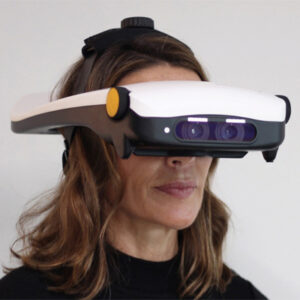Refractive: Hot topics in ophthalmology
December 2022
by Liz Hillman
Editorial Co-Director
Still a relatively new technology that is being incorporated into more and more devices, epithelial mapping use continues to become more widespread among refractive surgeons. From an availability standpoint, Dan Reinstein, MD, who pioneered mapping the epithelium, said “every OCT company is developing or has developed this functionality into their machines: Avanti OCT [Optovue], MS39 OCT [CSO Italia], Cirrus OCT [Carl Zeiss Meditec], and Anterion OCT [Heidelberg]. This is in addition to the Insight 100 [ArcScan], which uses the Artemis very high-frequency [VHF] digital ultrasound technology, and the Precisio [iVis] ultra-thin blue scanning laser slit tomography.”
“As more doctors get routine access to epithelial thickness maps, there are an increasing number of publications,” Prof. Reinstein said.
William Trattler, MD, said that while epithelial thickness mapping has been on everyone’s radar for a while, like Prof. Reinstein, he thinks that more physicians are incorporating it into their diagnostic practice.
“We’re still trying to understand a bit better how it will help us clinically,” Dr. Trattler said.
In March 2021, EyeWorld spoke with Prof. Reinstein and others about the utility of epithelial mapping in their practice. At the time, Prof. Reinstein shared the history of developing epithelial mapping and where it has come since then:
Prof. Reinstein developed epithelial mapping and applications as a bioengineering research fellow working in D. Jackson Coleman’s lab with Ronald Silverman, PhD. Prof. Reinstein was the first to measure the epithelium of the cornea in vivo in 1991 using VHF digital ultrasound and the first to produce a 3-mm map of the epithelium in 1993.1 He went on to develop the first method of mapping the full 10-mm epithelial profile of the cornea by 19972 when he began scanning and elucidating the epithelial changes in LASIK and analyzing the complications of corneal refractive surgery. With this work and the commercialization of the first epithelial mapping device (ArcScan Insight 100 VHF and other anterior segment OCT devices with this capability), Prof. Reinstein is considered to be the “father” of this new diagnostic field of layered corneal diagnostics.
“Having developed and worked with VHF digital ultrasound for 20 years prior, I was excited to help Optovue develop the first OCT prototype device to map the corneal epithelium in 2012, which commercially launched in 2015. Most anterior segment OCT manufacturers are now developing this capability for their devices,” Prof. Reinstein said. “This is becoming the standard of care for refractive surgery diagnostics.”
[…]
According to Prof. Reinstein’s work, the average central epithelial thickness in a normal cornea was 53.4 µm with a standard deviation of 4.6 µm,3 measured by the gold standard method, Artemis 60 MHz 3D VHF digital ultrasound.
“This indicated that there was little variation in central epithelial thickness in the population,” he said. “The thinnest epithelial point within the central 5 mm of the cornea was displaced on average 0.33 mm (±1.08) temporally and 0.90 mm (±0.96) superiorly with reference to the corneal vertex. Studies using OCT have confirmed this superior-inferior and nasal-temporal asymmetric profile for epithelial thickness in normal eyes.”3
Prof. Reinstein first postulated in 1994 that this inferior/superior asymmetry is produced by the balance of forces of epithelial outward growth and the combined inward forces produced by the eyelids, the upper eyelid producing more inward force than the lower lid, he explained.4

Source: Reprinted with permission from SLACK Incorporated. Reinstein DZ, et al. Epithelial, stromal, and total corneal thickness in keratoconus: three- dimensional display with Artemis very-high frequency digital ultrasound. J Refract Surg. 2010;26:259–271.
As in the March 2021 article, many physicians find epithelial mapping helpful in keratoconus detection.5 Prof. Reinstein told EyeWorld that while the Insight 100 VHF digital ultrasound (VHFDU) is the “gold standard” because it measures the epithelium alone without the tear film, which can vary in thickness between blinks, it takes more time. Therefore, he said he uses OCT epithelial mapping for keratoconus screening routinely for all patients. From there, he said about 10% of suspects will go on to receive an Insight 100 epithelial thickness map to further rule out keratoconus and inform their options for corneal refractive surgery. Prof. Reinstein added that obtaining anterior segment scans at the same time also means that the necessary measurements are available for optimal ICL sizing, if the patient is found not to be suitable for corneal surgery.
“Sizing with VHFDU using our new formula6 appears to have reduced ICL exchange rates to less than 1 in 200. This is available at www.iclsizing.com,” Prof. Reinstein said.
Dr. Trattler also sees the value in using epithelial mapping to rule out keratoconus for possible refractive surgery. Dr. Trattler said there are a lot of sophisticated technologies refractive surgeons are currently using to help assess candidates, including evaluating corneal shape, thickness maps of the entire cornea, relative thickness maps, corneal biomechanics, scoring systems, etc.
“We use a lot of information provided by these technologies to determine refractive surgery candidacy, but there are still patients who are borderline. Is it truly keratoconus or not?” he said, explaining that what might look like keratoconus could in fact be epithelial hyperplasia, the latter of which wouldn’t rule out corneal refractive surgery.
While epithelial mapping is not critical for a practice in Dr. Trattler’s mind, he said it is quicker than waiting to assess for possible keratoconus progression 6 months to a year later.
“This provides a rapid way of understanding what’s going on now versus monitoring patients over time,” he said.
Arjan Hura, MD, also does not think that epithelial mapping is standard of care yet, but he took an informal survey of refractive surgeons and found that of 88 respondents, 60% routinely use it. He personally will get an epithelial map for patients with borderline or irregular topography and when planning enhancements. For the latter, it helps him ascertain what degree of the postoperative refractive shift may be due to zonal epithelial hyperplasia.
“I keep in mind that ocular surface disease, recent instillation of topical drops, and contact lens wear can impact the appearance of the epithelial maps. I don’t make decisions based solely off epithelial mapping, and the amount of significance I give it varies by case,” Dr. Hura said. “Overall, I view epithelial mapping as a valuable additional data point that has potential to help the surgeon in clinical decision making.”

Source: Jessica Heckman, OD, and Ralph Chu, MD
Dr. Hura explained that he finds epithelial mapping most helpful in the context of topography. He offered these examples: (1) An area of topographic steepening with overlying corresponding epithelial thinning would be potentially concerning for keratoconus or ectasia. However, if the epithelium in that area of steepening is thick, it may be that the epithelium is what is causing the steepening and not necessarily some underlying weakness in the cornea. (2) Epithelial hyperplasia in the central area of a previous myopic ablation that appears normal on topography could explain why a patient has experienced a regression in their myopic refractive error. (3) Epithelial maps may suggest subclinical EBMD if there is mild irregular astigmatism on topography and the exam is unremarkable. (4) Unremarkable topography in the postoperative period after refractive surgery in a patient now with unsatisfactory vision who has variable epithelial mapping may suggest that healing is still taking place.
Neda Shamie, MD, who said she performs epithelial mapping to detect keratoconus, doesn’t think epithelial mapping is considered the standard of care among refractive surgeons yet either.
“I think that tomography and topography are the two critical diagnostic tools with epithelial mapping supplementing the information,” she said. “It’s possible with improvements in technology and further understanding of the results we get that it could potentially move up the ladder of importance. In screening refractive surgical patients, especially as we’re trying to screen for conditions that would not yet be overtly evident, the more information we have, the more confidence we can have in recommending surgery. After all, my job as a refractive surgeon is not just to perform expertly done surgery but to determine safety long term for our patients. To me, risk assessment is the more challenging part of my job as a refractive surgeon.”
If a practice is not using this functionality or doesn’t have a device that performs epithelial mapping yet, Dr. Trattler said a refractive surgeon should discern whether they want to incorporate a technology like this that is going to potentially allow more patients to qualify for corneal refractive surgery who might have otherwise been excluded.
“Are surgeons willing to acquire epithelial mapping to rule potential patients in for corneal refractive surgery? If surgeons rule patients out because they do not have epithelial mapping available, it’s not the end of the world, but obviously for patients interested in refractive surgery, it would be great to have epithelial thickness mapping available to identify the anatomical cause for inferior corneal steepening on topography,” Dr. Trattler said.
About the physicians
Arjan Hura, MD
Maloney-Shamie Vision Institute
Los Angeles, California
Dan Reinstein, MD, MA(Cantab)
London Vision Clinic
EuroEyes Group
London, United Kingdom
Neda Shamie, MD
Maloney-Shamie Vision Institute
Los Angeles, California
William Trattler, MD
Center for Excellence in Eye Care
Miami, Florida
References
- Reinstein DZ, et al. High-frequency ultrasound measurement of the thickness of the corneal epithelium. Refract Corneal Surg. 1993;9:385–387.
- Reinstein DZ, et al. Arc-scanning very high-frequency digital ultrasound for 3D pachymetric mapping of the corneal epithelium and stroma in laser in situ keratomileusis. J Refract Surg. 2000;16:414–430.
- Reinstein DZ, et al. Epithelial thickness in the normal cornea: three-dimensional display with Artemis very high-frequency digital ultrasound. J Refract Surg. 2008;24:571–581.
- Reinstein DZ, et al. Corneal pachymetric topography. Ophthalmology. 1994;101:432–438.
- Reinstein DZ, et al. Corneal epithelial thickness profile in the diagnosis of keratoconus. J Refract Surg. 2009;25:604–610.
- Reinstein DZ, et al. New sizing parameters and model for predicting postoperative vault for the implantable collamer lens posterior chamber phakic intraocular lens. J Refract Surg. 2022;38:272–279.
Relevant disclosures
Hura: Carl Zeiss Meditec
Reinstein: ArcScan, CSO Italia, Carl Zeiss Meditec
Shamie: None
Trattler: ArcScan, Carl Zeiss Meditec, Oculus
Contact
Hura: ah@maloneyshamie.com
Reinstein: dzr@londonvisionclinic.com
Shamie: ns@maloneyshamie.com
Trattler: wtrattler@gmail.com


